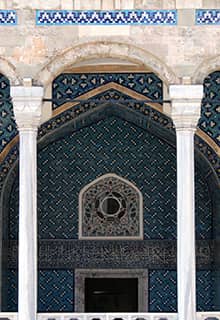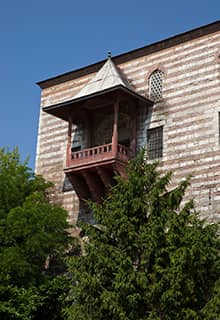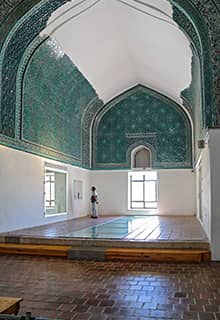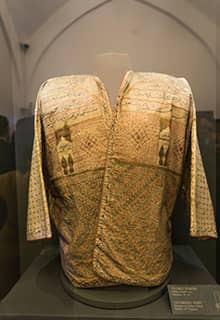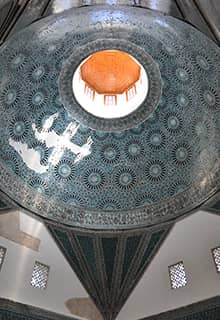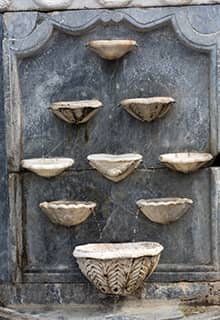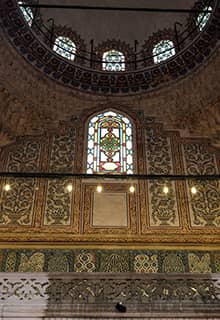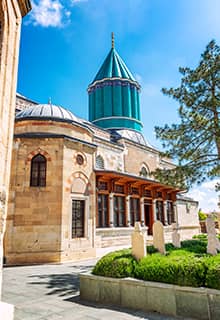

museums and centers of
Turkish and Islamic art
in Türkiye
İstanbul
Turkish and Islamic Arts Museum
The Turkish and Islamic Arts Museum is the first Turkish museum dedicated exclusively to Turkish and Islamic arts. The foundation of the museum dates back to the end of the 19th century and its establishment was completed in 1913. The museum opened to the public in the building of the soup kitchen of the Süleymaniye Mosque Complex, one of the most important works of Mimar Sinan. At the time, it was known as the ‘‘Evkaf-ı İslamiyet Müzesi’’ (Islamic Foundations Museum). When the Republic was established, the museum’s name was changed to “Turkish and Islamic Arts Museum.’’
The museum was moved to İbrahim Pasha Palace in 1983. Formerly the palace of the Grand Vizier of Süleyman the Magnificent, Pargalı İbrahim Pasha, the building is one of the most important samples of 16th-century Ottoman civil architecture. The palace is situated on the west side of the Hippodrome of Constantinople, the history of which dates back to the early centuries of the Common Era.
The Turkish and Islamic Arts Museum was awarded the Special Jury Award of the Museum of the Year Competition of the European Council in 1984, and was given a prize by the European Council - UNESCO for its work focused on enhancing the museum experience for children. The Turkish and Islamic Arts Museum is among the world’s most important museums in its field with works from almost all periods and all types of Islamic art. Its magnificent collection exceeds 40,0000 artifacts.
Carpet Section
The Turkish and Islamic Arts Museum’s carpet section forms the richest collection of carpets in the world. It is so famous that it led to the museum being known as the ‘‘Carpet Museum’’ for many years. Besides rare Seljuk carpets, the museum has prayer rugs, carpets featuring animal figures from the 15thcentury, and carpets produced in Anatolia between the 15th and 17th centuries that became known as “Holbein carpets” in the West as a result of their depiction in the paintings of Hans Holbein the Younger. These precious artifacts were inspired by geometrical figures or Kufic script and form the most valuable part of the carpet collection.
The Turkish and Islamic Arts Museum carpet collection was enriched with Iranian and Caucasian carpets, carpets from Uşak, a city in the interior Aegean region, and palace carpets. The collection is a reference point for all scholars and researchers of the art of carpet weaving.
Handwriting and Calligraphy Section
Qurans constitute a large part of the manuscript collection of the Turkish and Islamic Arts Museum, dating from the 7th to the 20th century and coming from a large geographical region where Islam had spread. In this section, apart from Qurans, there are manuscripts on a variety of subjects that draw attention both in terms of their writing styles and their book covers.
Imperial edicts, warrants bearing the signatures of Ottoman sultans, and samples of Turkish and Iranian miniature scripture make the Museum of Turkish and Islamic Arts one of the most important and interesting museums in the world.
Woodwork Section
The most important parts of the woodwork collection are the samples of Anatolian woodwork from the 9th and 10th centuries. Apart from the unique artifacts that have survived from the Anatolian Seljuks and the Anatolian Beyliks (principalities), other interesting items found in the collection include wood-carved items featuring mother of pearl, ivory, and tortoiseshell from the Ottoman period, unique samples of wood inlay, Quran cases, and bookrests.
Stonework Section
The Museum of Turkish and Islamic Arts houses stonework from the Umayyad, Abbasid, Mamluk, Seljuk, and Ottoman periods. Some of the artifacts feature decorative motifs and others present viewers with figures, while all of them have writings. This section contains unique and high-quality samples of stonework from the Seljuk period; gravestones with hunting scenes and mythical creatures such as sphinxes, griffins, and dragons; early stonework with Kufic script and later work with inscriptions written in styles developed by Ottoman calligraphers.
Ceramic and Glass Section
In the ceramic and glass section there are mostly ceramic works found in excavations conducted in 1908-1914 in Samarra in modern-day Iraq, Rakka and Tel Halep in modern-day Syria, and Keşan in Türkiye.
The museum’s collection offers visitors a chance to admire ceramic work from the Early Islamic period. Important parts of the collection include encaustic tile samples from mosaics, mihrabs, and walls from the Anatolian Beyliks and the Seljuk period, and the plaster ornamentation from the Kılıçaslan Palace in Konya. The Ottoman tradition of encaustic tiles and ceramic art continued until the recent past with Kütahya and Çanakkale ceramics.
Metalwork Section
The metalwork section starts with unique samples from the Great Seljuk Empire. The collection includes mortars, censers, long-spouted ewers, mirrors, and silver coin (dirhem) door knockers from the Cizre Ulu Mosque; and 14th-century candelabra ornamented with constellation and planet symbols. Among the Ottoman metalwork displayed in the museum, starting from the 16th century and reaching the 19thcentury, there are silver and brass metalwork, tombac crests ornamented with valuable stones, candleholders, rosewater bottles, censers, and washbasin and pitcher sets.
Ethnography Section
This is the newest part of the museum and it exhibits carpet/kilim looms collected from various regions of Anatolia, public weaving and ornamental art samples, regional costumes, household goods, handicrafts, and nomad tents, while it also informs visitors, among others, of wool yarn dyeing techniques.
The Museum of Turkish Calligraphy Art
The Museum of Turkish Calligraphy Art is housed in a building which formerly served as the madrasa of the Bayezid II Complex. It was constructed between 1506 and 1508. The collection consists of 3,121 pieces mainly reflecting the art of Islamic calligraphy. There are also examples of miniatures, stonework, and glasswork. The museum offers visitors the opportunity to learn about the elaborate form of the seals and signatures of the Ottoman sultans that are known as tuğras (tughras).
Museum of Islamic Art (Tiled Kiosk)
The Museum of Islamic Art (Tiled Kiosk) is one of the three museums that comprise the İstanbul Archaeology Museums. The Tiled Kiosk was commissioned by Sultan Mehmed II in 1472. It is one of the oldest structures of Ottoman civil architecture in İstanbul and was once part of Topkapı Palace’s outer gardens. The building was used as the Imperial Museum between 1875 and 1891, before the collection was moved to a newly constructed building. The kiosk was opened to the public in 1953 as a museum of Turkish and Islamic art, and contains many great examples of İznik tiles and Seljuk pottery.
Sadberk Hanım Museum
The Sadberk Hanım Museum occupies two separate 19th-century wooden villas. The museum’s collection has grown rapidly and today contains over 20,000 objects. The Turkish-Islamic art section consists of examples of early Islamic art, Seljuk art, Ayyubid and Mamluk art, Timurid and Safavid art, and art from the Ottoman period.
The exhibition of Turkish-Islamic art starts with the room on the first floor where metal, ceramic, and glass artifacts from the Seljuk, Ayyubid, Mamluk, Timurid, and Safavid periods are exhibited in chronological order.
Sadberk Hanım Museum’s İznik ceramic collection is one of the leading collections in the world. The collection beautifully illustrates the development of İznik ceramic art from the end of 15th to the middle of the 17th century. The achievements of Ottoman ceramic art between the 18th and 20th centuries can be seen in the displays where Kütahya and Çanakkale ceramics are exhibited.
The silver artifacts with tuğras and tombak objects are among the most distinguished works in the museum. Calligraphic work, created by some of the leading calligraphers of the Ottoman period, is on display on the second floor of the Turkish and Islamic section.
Also on the second floor, one finds outstanding examples of Ottoman weaving, embroidery, and a rich collection of women's costumes from the Ottoman period. Moreover, Ottoman traditions and customs such as henna nights, bridal baths, childbirth traditions, and circumcision receptions are introduced to visitors in entertaining and informative ways.
İstanbul Museum of the History of Science and Technology in Islam
The İstanbul Museum of the History of Science and Technology in Islam displays of replicas of scientific instruments created by Muslim scholars between the 9th to the 16th centuries. Most of the replicas were made by the Institute for the History of Arab-Islamic Sciences at the Johann Wolfgang Goethe University in Frankfurt. The replicas are based on the descriptions and pictures in the written sources, and some have been recreated from the original surviving works. Visitors are presented with maps and map drawings related to mines, physics, mathematics/geometry, urbanism and architecture, optics, chemistry and geography.
Some of the must-see replicas of inventions in the museum include:
- A copy of the world map drawn by Muhammad al-Idrisi based on the map of Caliph Al-Ma’mun.
- Taqī ad-Dīn’s mechanical clock, created in 1559.
- The elephant clock and hacamati (wet cupping or medicinal bleeding), from the book of Ismail al-Jazari (1200).
- Abu Sa’id al-Sijzi’s planetarium.
- Abd al-Rahman al-Sufi’s celestial sphere.
- Abu-Mahmud Khojandi’s (al-Khujandi’s) astrolabe.
- Scales by Al-Khazini from the 12th century.
- Ibn Sina’s medical encyclopedia Al-Qanun Fi al-Tibb (The Canon of Medicine).
- A reconstruction of the large globe from the time of Caliph Al-Ma’mun in the 9th century.
BURSA
Museum of Turkish and Islamic Arts
Bursa’s Museum of Turkish and Islamic Arts is located in the former madrasa of the Green Mosque (Yeşil Cami), which was constructed on the order of Ottoman Sultan Mehmed I in 1419. The name “Green Mosque” comes from its green and blue interior tile decorations. The mosque is now a popular tourist destination in Bursa and has been designated as an UNESCO World Heritage Site.
The museum includes examples of tiles and ceramics from the Seljuk, Anatolian Beyliks, and Ottoman periods (İznik, Kütahya), woodwork, carving and inlaid works, examples of Turkish metal art, tombak and other metal artifacts, and Seljuk and Ottoman coins. Traditional Turkish food and clothes are also included in the inventory.
KONYA
Karatay Madrasa Tile Museum
The Karatay Madrasa Tile Museum, which opened to the public in 1955, is housed in the magnificent Karatay Medrese, built in 1251 by the Seljuks. The medrese (madrasa) is a masterpiece of stonework and ceramic art, and as such offers a perfect setting for the museum. A visit here is one of the highlights of any trip to Türkiye. The stunning visual effect of the turquoise, indigo, and black tiles decorating the squinches of the massive dome is breathtaking.
Mevlâna Museum
The Dervish Lodge that is presently used as a museum was formerly the rose garden of a Seljuk palace.The museum’s courtyard is entered via the Dervişan Kapısı, the Gate of the Dervishes. There are dervish cells along the north and west sides of the courtyard.
The courtyard is endowed with a special atmosphere by the roofed ablution fountain (şadırvan or shardivan in English) built by Sultan Selim I in 1512; the Şeb-i Arus pool (Şeb-i Arus refers to Mevlana’s “Wedding Day,” or his reunion with his Beloved upon his death); and the fountain which is located in the northern part of the court.

